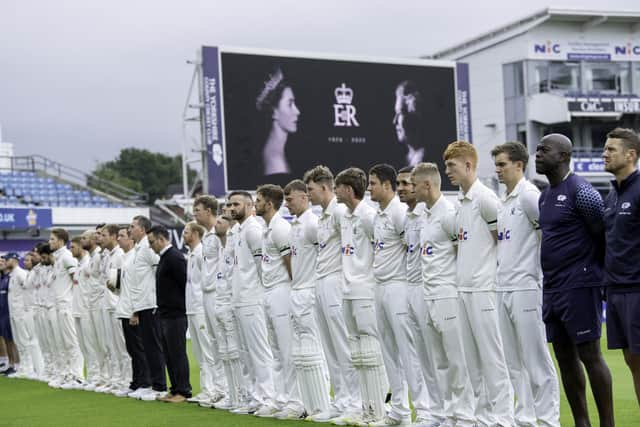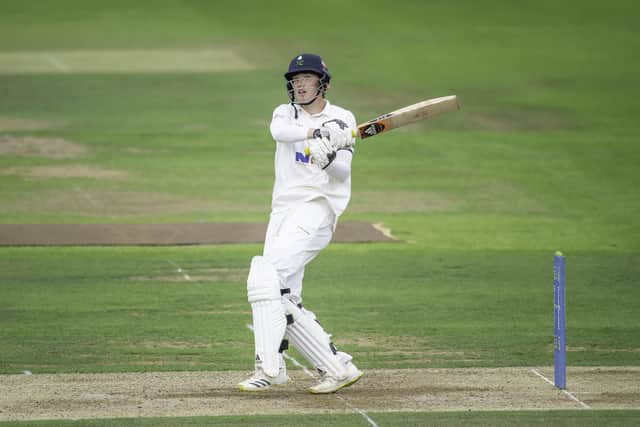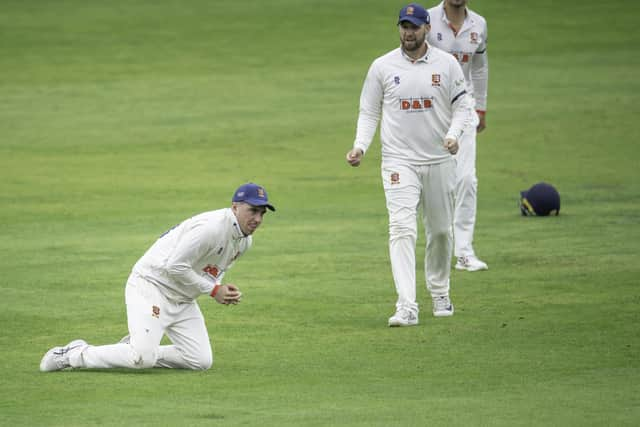Yorkshire CCC honour The Queen before seeing wickets tumble against Essex at Headingley
It was Raymond Illingworth’s first-class debut, and Yorkshire beat Hampshire by 10 wickets, captain Norman Yardley scoring a career-best 183 not out and all 20 Hampshire wickets falling to spin - 10 to Bob Appleyard, eight to Eddie Leadbeater, and two to Johnny Wardle.
A little over 71 years on, and there was scant chance of spin playing much of a role yesterday.
Advertisement
Hide AdAdvertisement
Hide AdAfter the teams lined up in front of the pavilion for a minute’s silence in memory of Her Majesty, followed by a rendition of God Save the King, pace dominated as Yorkshire were dismissed for 134 after losing the toss, rain then preventing the Essex reply from starting following the tea break.
In front of a sparse crowd by Headingley’s standards, with perhaps no more than 1,000 or so present, wickets tumbled in challenging conditions on a grey and gloomy, muggy sort of day.
The floodlights were on from the get-go, as if it was 10.30 at night as opposed to 10.30 in the morning, the bulbs piercingly bright in front of banks of dark cloud, which added to the sombre feel nationally in recent days.
The players wore black armbands in honour of The Queen, armbands that clung tightly to their biceps as if the respective medical departments were checking on their blood pressure.
Advertisement
Hide AdAdvertisement
Hide AdYorkshire’s was perhaps a tad higher come day’s end, although nothing that a few quick wickets in the morning would not soon put right.


There was an end-of-season feel about the famous old ground, with neither side in the hunt for silverware, albeit with Yorkshire not quite out of the relegation woods.
The theme of falling wickets was established in the morning’s fourth over, Fin Bean caught behind for an 11th-ball duck as Sam Cook got one to shape away from the left-hander at the Kirkstall Lane end.
Cook was excellent, making the most of the help that was available, and after Adam Lyth had nibbled at a ball from Jamie Porter and been caught behind to leave Yorkshire 22-2, Cook achieved a niche if notable milestone.
Advertisement
Hide AdAdvertisement
Hide AdFor when he had Tom Kohler-Cadmore edging a defensive push to third slip, Cook - the 25-year-old right-arm seamer with designs on representing his country - became the first English player since 1971 to achieve 200 first-class wickets at an average of under 20, a feat last performed by Alan Ward, of Derbyshire, and one which narrowly eluded Yorkshire’s Ben Coad last week.


After striking his first ball to the cover boundary off Porter, Kohler-Cadmore managed only one more run from his other 43 balls faced. It was a sign of how well Essex bowled and the challenge at hand; it was a fortuitous toss for Tom Westley to win. The visitors claimed a fourth wicket before lunch when Will Fraine was beaten and bowled on the outside edge by Shane Snater.
But George Hill stood firm to reach 32 at the break, the all-rounder something of a lone hand with the bat as he had been a lone hand with the ball to begin with in the game at Old Trafford, where he captured a career-best 6-26 in the Lancashire first innings.
Hill is a talent, just 21 years young, but he added only four more to his score before nibbling at Cook to give him his third scalp.
Advertisement
Hide AdAdvertisement
Hide AdThe scoreboard showed 87-6 when Matty Revis - one of two changes from the Roses match as he came in for Matthew Waite, with Jack Shutt replacing the rested Dom Bess - pushed forward at Snater and was caught behind.


Snater bagged his third when Jonny Tattersall was bowled for a useful 32 from 49 balls, including seven boundaries, and the hosts fell to 100-8 when Jordan Thompson edged a drive off Ben Allison to Sir Alastair Cook at first slip.
Coad thumped 17 from 12 deliveries - including the epitome of a stand-and-deliver straight six off Snater into The Howard Stand - before the fun and games ended when he fended a bouncer from Allison into his stumps.
Porter trapped last man Shutt, and Yorkshire were dismissed in 52.2 overs, at which point an early tea was called.
Advertisement
Hide AdAdvertisement
Hide AdThere was barely enough time to queue for the press box gruel when the black skies wept on to the playing area, resulting in the loss of the last 43 overs and depriving Yorkshire’s bowlers of the chance to make hay while the sun refused to shine.
The abiding memory of the day, though, will be the respectful scenes before the start, when Yorkshire and Essex paid tribute to The Queen.
Yorkshire CCC has long links with the Royal Family; its patroness is The Duchess of Kent, whose father, Sir William Worsley, was club president from 1961-1973. Leslie Ferrar, one of the new board members, is a former treasurer to The Prince of Wales, now King Charles III.
Never have those links seemed more poignant and pertinent.